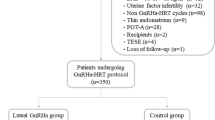Abstract
Objective
To study the effect of GnRh agonist administration prior to estrogen–progesterone preparation of the endometrium on the implantation rate in frozen–thawed embryo transfer (FET) cycles in infertile patients treated with IVF/ICSI.
Design
Prospective controlled study.
Setting
Private center in Alexandria, Egypt.
Patients
Patients undergoing frozen–thawed embryo transfer FET.
Intervention(s)
Patients were divided into two groups, A and B. Group A patients consisted of 110 patients (110 cycles) who received daily subcutaneous injections of 0.1 mg of the GnRh agonist triptorelin starting from the mid-luteal phase of the cycle preceding the actual FET cycle. The dose was reduced to 0.05 mg from the second day of the cycle when daily oral estradiol valerate 6 mg was also started. Daily vaginal supplementation of micronized progesterone 400 mg b.d. was started after 12 days when the GnRh agonist was also stopped. Frozen–thawed embryos were transferred on day + 1 of their chronological age and when the endometrium reached 12 mm in thickness. Group B consisted of 100 patients (100 cycles) who started daily estradiol valerate 6 mg administration from the second day of the FET cycle and followed the same regimen but without prior treatment with triptorelin.
Main Outcome Measures
Implantation and pregnancy rates were compared among the two groups.
Results
There was a significant increase in implantation rate in the GnRh agonist group (group A) compared to the estrogen and progesterone only group (group B) (44.1 vs. 21.1 %; P = 0.002*). The pregnancy rate was also significantly higher in group A compared to group B (65.5 vs. 42 %, P = 0.013*).
Conclusions
GnRh agonist administration during endometrial preparation for FET increases the implantation and pregnancy rates.
Similar content being viewed by others
References
Skovmand K. Blastocyst frozen embryo transfer (FET): comparison of outcome with replacement in natural or programmed/medicated cycle. Fertil Steril. 2004;82:s154.
Ghobara T, Vandekerckhove P. Cycle regimens for frozen–thawed embryo transfer. Cochrane Database Syst Rev. 2008;(1):CD003414. doi:10.1002/14651858.CD003414.pub2.
Cohen J, DeVane GW, Elsner CW, et al. Cryopreserved zygotes and embryos and endocrinologic factors in the replacement cycle. Fertil Steril. 1988;50:61–7.
Muasher SJ, Kruithoff C, Simonetti S, et al. Controlled preparation of the endometrium with exogenous steroids for the transfer of frozen-thawed pre-embryos in patients with anovulatory or irregular cycles. Hum Reprod. 1991;6:443–5.
Gelbaya TA, Nardo LG, Hunter HR, et al. Cryopreserved thawed embryo transfer in natural cycle or down-regulated hormonally controlled cycles: a retrospective study. Fertil Steril. 2006;85:603–9.
Andersen AG, Als-Nielsen B, Hornnes PJ, et al. Time interval from human chorionic gonadotrophin (HCG) injection to follicular rupture. Hum Reprod. 1995;10:3202–5.
Nawroth F, Ludwig M. What is the ‘ideal’ duration of progesterone supplementation before the transfer of cryopreserved-thawed embryos in estrogen/progesterone replacement protocols? Hum Reprod. 2005;20:1127–34.
Dor J, Rudak E, Davidson A, et al. Endocrine and biological factors influencing implantation of human embryos following cryopreservation. Gynecol Endocrinol. 1991;5:203–11.
El Toukhy T, Taylor A, Khalaf Y, et al. Pituitary suppression in ultrasound-monitored frozen embryo replacement cycles. A randomised study. Hum Reprod. 2004;19:874–9.
Queenan JT Jr, Veeck LL, Seltman HJ, et al. Transfer cryopreserved-thawed pre-embryos in a natural cycle or a programmed cycle with exogenous hormonal replacement yields similar pregnancy results. Fertil Steril. 1994;62:545–50.
Lelaidier C, de Ziegler D, Gaetano J, et al. Controlled preparation of the endometrium with exogenous oestradiol and progesterone: a novel regimen not using a gonadotrophin-releasing hormone agonist. Hum Reprod. 1992;7:1353–6.
Oehninger S, Mayer J, Muasher S. Impact of different clinical variables on pregnancy outcome following embryo cryopreservation. Mol Cell Endocrinol. 2000;169:73–7.
Lotradi KE, Kolibiankis EM, Venetis CA, et al. Cryopreservation of human embryos by vitrification or slow freezing: a systemic review and meta-analysis. Fertil Steril. 2008;90:186–93.
Kuwayama M. Highly efficient vitrification for cryopreservation of human oocytes and embryos: the cryotop method. Theriogenology. 2007;67:73–80.
Glujovsky D, Pesce R, Fiszbajn G, et al. Endometrial preparation for women undergoing embryo transfer with frozen embryos or embryos derived from donor oocytes. Cochrane Database Syst Rev. 2010;20:CD006359.
Yang X, Dong X, Huang K, et al. The effect of accompanying dominant follicle development/ovulation on the outcomes of frozen-thawed blastocyst transfer in HRT cycle. Int J Clin Exp Pathol. 2013;6:718–23.
Author information
Authors and Affiliations
Corresponding author
Ethics declarations
Conflict of interest
The authors have no conflict of interest.
Ethical Approval
All procedures performed in the study were in accordance with the ethical standards of the institutional and/or national research committee and with the 1964 Helsinki Declaration and its later amendments or comparable ethical standards.
Informed Consent
Informed consent was obtained from all individual participants included in the study.
Additional information
Sherif Anis Hebisha is a Lecturer of Obstetrics and Gynecology at Alexandria University Faculty of Medicine, Embryology Laboratory Director of Madina Fertility Center and Clinical fellowship at Yale University OBGYN department. H. M. Adel is a Lecturer of Obstetrics and Gynecology at Faculty of Medicine, Alexandria University.
Rights and permissions
About this article
Cite this article
Hebisha, S.A., Adel, H.M. GnRh Agonist Treatment Improves Implantation and Pregnancy Rates of Frozen–Thawed Embryos Transfer. J Obstet Gynecol India 67, 133–136 (2017). https://doi.org/10.1007/s13224-016-0936-5
Received:
Accepted:
Published:
Issue Date:
DOI: https://doi.org/10.1007/s13224-016-0936-5




